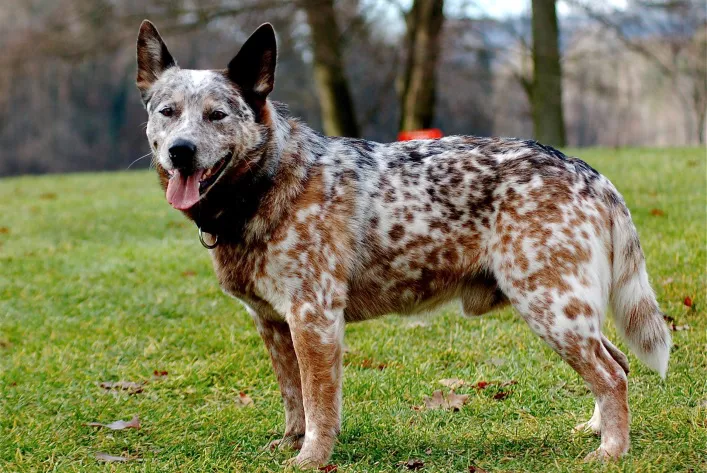The Australian Cattle Dog, often referred to as the “Queensland Heeler” or “Blue Heeler,” is a remarkable breed known for its exceptional herding abilities, intelligence, and unwavering loyalty. This unique working dog hails from the land down under and has a rich history closely tied to the development of Australia’s cattle industry. In this comprehensive article, we will explore the Australian Cattle Dog’s history, temperament, physical characteristics, training needs, health considerations, and the role they play in modern society.
History and Origins
The Australian Cattle Dog’s story begins in the early 19th century when the European settlers arrived in Australia with their herds of cattle. The need for a breed capable of herding and managing these cattle became increasingly apparent. In response to this challenge, Australian pioneers began to experiment with breeding dogs to create the ultimate herding companion.
The result of this breeding experimentation was the Australian Cattle Dog, which is believed to be a blend of various breeds, including the Dalmatian, Collie, and Australian Kelpie. The most influential ancestor of the Australian Cattle Dog, however, was a breed known as the Smithfield, which was brought to Australia by Thomas Hall, a cattle farmer from Northumberland, England.
The Australian Cattle Dog’s blue coat is a distinctive feature, and this breed is often referred to as the “Blue Heeler” due to its unique speckled appearance. This blue coat was likely inherited from the Dalmatian lineage. The breed’s exceptional herding abilities can be attributed to the Collie influence, while the Australian Kelpie contributed to their agility and endurance.
Temperament
The Australian Cattle Dog is known for its intelligence, loyalty, and strong work ethic. They are natural problem solvers and thrive when given both physical and mental challenges. However, their intelligence also means they can be headstrong and independent, which can pose training challenges if not managed properly.
Australian Cattle Dogs are fiercely loyal to their owners, making them excellent family pets. They often form deep bonds with their human companions and are known for their protective nature. While they are not inherently aggressive, they can be reserved around strangers and tend to be territorial.
These dogs are known to be energetic and require ample exercise and mental stimulation to stay content. Due to their herding instincts, they may display nipping behaviors, especially when interacting with children. Early socialization and training are essential to ensure that their natural instincts are channeled appropriately.
Physical Characteristics
The Australian Cattle Dog is a medium-sized breed with a well-balanced and muscular build. Their distinctive blue coat is short, dense, and water-resistant, which allows them to withstand harsh weather conditions. This coat can come in two patterns: blue speckled or blue mottled, and it is often complemented by tan markings on the head, ears, legs, and tail.
Their strong, medium-length tail is often carried low and slightly curved. The ears are pricked and alert, and their eyes are oval-shaped and typically dark brown, conveying a sense of alertness and intelligence.
This breed has a strong, sturdy frame, with males typically standing between 18 to 20 inches at the shoulder and weighing around 35-50 pounds. Females are slightly smaller, standing at 17 to 19 inches and weighing 30-45 pounds.
Training and Exercise Needs
Training an Australian Cattle Dog can be both challenging and rewarding. Their high intelligence and strong work ethic make them quick learners, but their independent nature may also make them willful at times. It’s essential to start training early and use positive reinforcement techniques to keep them engaged.
These dogs thrive when given tasks and a sense of purpose. They excel in dog sports like obedience, agility, and herding trials. Regular, rigorous exercise is a must to keep them physically and mentally stimulated. Daily activities like fetch, hiking, and agility courses are great ways to keep an Australian Cattle Dog content and well-behaved.
Socialization is also crucial. Early exposure to different people, animals, and environments will help them develop into well-adjusted adults. Without proper socialization, they may become wary of strangers and exhibit aggressive or fearful behaviors.
The Role of Australian Cattle Dogs in Modern Society
Australian Cattle Dogs are renowned for their working abilities, particularly in herding livestock. Their dedication and tenacity have earned them a prominent place in the history of Australian agriculture. They are still used today on ranches and farms across the world for herding cattle and other livestock.
Apart from their traditional role in agriculture, Australian Cattle Dogs have also found success in other working roles. They have been employed in search and rescue operations, as therapy dogs, and in various dog sports. Their agility, intelligence, and problem-solving abilities make them versatile and valuable assets in many fields.
Additionally, these dogs have made a mark in the world of dog shows and obedience trials, where they often excel thanks to their intelligence and agility. Their striking appearance and distinctive blue coat also make them a favorite among dog enthusiasts.
In recent years, the Australian Cattle Dog has gained popularity as a family pet. Their loyalty and protective nature make them excellent companions, especially in active households that can provide the exercise and mental stimulation they require. However, it’s important for potential owners to understand the breed’s energy levels and training needs to ensure a harmonious relationship.


